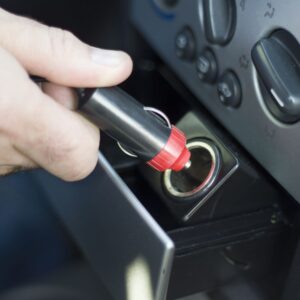Have you ever wondered why car windows look and behave differently than the windows in your home or workplace? Automotive window glass isn’t like the stuff used for windows in buildings. The glass that comprises the windshields and window panes in your car or truck must meet the demanding requirements for vehicular use. Let’s take a closer look at what makes automotive window glass different.
Common Types of Automotive Window Glass
Most car windows use either laminated glass or tempered glass. The specific type depends on what the particular window requires of its glass. Front windshields need tough material, so they use laminated glass. In comparison, the side and back windows use tempered glass.
Laminated Glass
Laminated glass consists of a layer of polyvinyl butyral (PVB) sandwiched between two layers of glass. Pressure rollers seal the layers together, creating a mechanical bond between the glass and PVB. The layers also get treated with heat to chemically bond the PVB layer to the glass. Some laminated glass products have more than two layers of glass and the corresponding additional layers of vinyl.
How Is Laminated Glass Different?
The PVB layer makes laminated glass tougher than ordinary glass. PVB absorbs the energy imparted by a fast-moving object hitting one of the glass layers, significantly reducing the force that reaches the glass on the opposite side of the laminated glass. Furthermore, PVB holds the glass layers together. While laminated glass can still crack or get penetrated, it won’t shatter into fragments that might injure you and your passengers.
Laminated glass also deflects noise from outside the vehicle. Between the density of the multilayer glass and PVB’s ability to absorb energy, laminated glass reduces the noise that reaches the interior cabin.
As an added bonus, laminated glass also helps control the temperature in your vehicle. The PVB layer repels most of the UV rays in sunlight, reducing the heat generated by the light.
What Does Laminated Glass Do?
Laminated glass makes the windshield strong enough to withstand the passenger air bag bouncing off it when the safety device rapidly deploys during a collision. The windshield absorbs much of the impact, slowing down the airbag to prevent injury to the passenger. Laminated glass also reduces the risk of the passenger getting thrown out the vehicle by preventing the windshield from shattering.
The windshield also provides structural support for the roof. Even if the vehicle rolls over or turns turtle, the windshield remains strong enough to prevent the roof from collapsing.
Tempered Glass
Tempered glass is produced by its namesake process that heats glass before rapidly cooling it with a blower system. Parts of the heated glass cool at different rates, leading to different results.
The heated glass surface cools faster, causing it to contract. It also creates compressive stress that increases the material’s compressive strength. In contrast, the center of the heated glass expands because it loses heat at a slower rate. It produces tensile stress, which enhances the tensile strength of the material.
This process makes tempered glass very strong. While other glass types have either high compressive strength or tensile strength, tempered glass has both.
Furthermore, tempered glass breaks into small pieces without any sharp edges. The tempering process subjected the glass to both compressive and tensile stresses. The contraction and expansion of the glass generated considerable energy. When the tempered glass shatters, it releases the energy, breaking the glass into small pieces. A broken window made of tempered glass is less likely to injure the vehicle’s occupants because it breaks into small, dull pieces instead of large shards with jagged and sharp edges.
However, tempered glass isn’t perfect. The edges of a tempered glass piece are much weaker than the rest. This fragility is mitigated by grinding down the edges.
Uses For Tempered Glass
Tempered glass is used for the vehicle’s sidelites, the windows on either side of a door or larger window. It’s also used for the “backlite,” which is what automakers generally call the window we usually think of as the “rear windshield” over the package tray.
New Automotive Window Glass Types
Car manufacturers keep adding more glass to their vehicle models. The windshield keeps getting bigger while the roof accommodates a sunroof or gets completely replaced with panoramic glass. Glass manufacturers must improve existing types or develop entirely new automotive window glass products that can meet the new requirements.
Gorilla Glass
When laminated glass isn’t strong and light enough for the job, car manufacturers turn to Gorilla Glass. Developed by Corning, Gorilla Glass uses a different process to chemically strengthen the glass.
The proprietary process dips thin glass sheets into an ion-exchange bath of molten potassium-salt. Sodium ions leave the glass, giving way to potassium ions that are larger and diffuse deeper into the material. The potassium ions create a layer of compressive stress on the surface, making Gorilla Glass much stronger. Gorilla Glass is also lighter than older laminated glass products.
Gorilla Glass is used to make cover glass for smartphones. Recently, car manufacturers have started incorporating windows made of the new laminated glass in some models.
Silver-Coated Glass
This glass type embeds silver particles in the material to help with temperature regulation when it’s extremely hot or cold. Invisible to the unaided human eye, the coating reflects infrared light away from the glass. Since infrared light produces heat, the silver-coated glass helps keep the interior cool.
Silver-coated glass works in a different way during cold conditions. Silver is an excellent electrical conductor. The climate control system can send electricity through the silver coating, heating the windshield and melting ice.
Heated Glass
Ford’s heated glass system, known as Instaclear, was an innovative feature introduced in the all-new 1986 Ford Taurus and Mercury Sable. Ford placed a nearly invisible mesh of silver and zinc-oxide wires about 100-billionths of a meter thick between the two sheets of glass that make up the windshield.
When power was applied, this wire mesh would heat up, clearing the windshield of even very heavy ice within a couple of minutes. It functioned similarly to the rear defrost system but allowed visibility rather than having a visible grid.
Today, many luxury vehicle lines like Bentley, Jaguar, Lamborghini, Porsche, Rolls Royce, and others still use this system. It’s even used on the VW ID.4.
Recycled Glass
Laminated and tempered glass are so tough that recycling them poses a challenge. It usually isn’t worth the trouble of separating the glass into their ingredients. However, some car manufacturers and glass suppliers have decided to invest in methods and machinery to recycle laminated and tempered glass.
Automotive window glass is just as vital for your car as the metal and plastic that make up other parts. Whether it’s the laminated glass in the windshield, tempered glass in the side windows, or one of the up-and-coming new types, car window glass keeps you safe and comfortable.
Any information provided on this Website is for informational purposes only and is not intended to replace consultation with a professional mechanic. The accuracy and timeliness of the information may change from the time of publication.

































